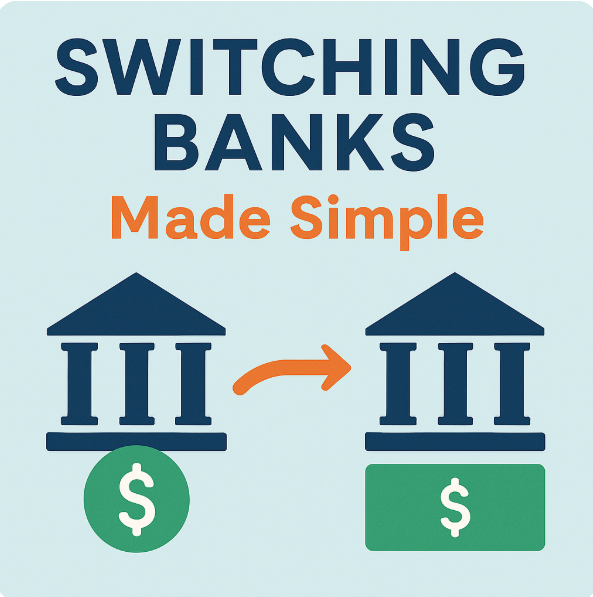If your bank has been quietly eating away at your balance with “maintenance,” “paper statement,” or “non-activity” fees, it’s time to make a move.
Too many Americans stick with the same bank out of habit — even when that habit costs them hundreds of dollars a year.
The truth is, switching banks used to be a hassle. But today, it’s easier than ever to take your money somewhere that respects you.
Let’s talk about how to move your accounts safely, avoid disruptions, and start saving — all without the headaches.
Why People Stay with Bad Banks
Banks know inertia is profitable. They count on you not wanting to deal with the paperwork or phone calls.
You’ve probably told yourself one of these:
- “All banks are the same.”
- “It’s too complicated to switch.”
- “I’ve had this account for years; closing it might hurt my credit.”
Let’s bust those myths:
- No, all banks aren’t the same — some charge $0 monthly fees and others charge $15.
- Switching is now digital; most new banks handle the transition for you.
- Closing a checking or savings account does not impact your credit score.
Staying loyal to a bad bank is like tipping someone who just spilled your drink.
The Rise of Junk Fees
“Junk fees” are the little charges that chip away at your savings — maintenance fees, overdraft fees, out-of-network ATM charges, and “early closure” penalties.
According to the Consumer Financial Protection Bureau (CFPB), Americans lose billions each year to these unnecessary charges.
The good news?
You don’t have to put up with it. You can leave — and take your direct deposits with you.
Step-by-Step: How to Switch Banks the Smart Way
Here’s the safe, clean way to switch without missing a paycheck or a bill.
Step 1: Choose Your Next Bank Wisely
You want a financial institution that fits your lifestyle — not one that profits from your mistakes.
Ask yourself:
- Does this bank charge a monthly maintenance fee?
- What’s the minimum balance to avoid fees?
- Do they offer early direct deposit?
- Are they part of a large ATM network?
💡 Pro Tip: Look into credit unions, online banks, or community banks. Many offer no-fee checking and better interest rates than the “Big Four” (Chase, Bank of America, Wells Fargo, Citibank).
Step 2: Open Your New Account Before Closing the Old One
Don’t shut the old door before you open a new one.
Set up your new account first so you can transfer your recurring payments and direct deposits smoothly.
Be sure to:
- Deposit enough to activate the account.
- Set up your debit card PIN and online login.
- Test your mobile app to make sure it’s user-friendly.
Step 3: Make a List of Automatic Transactions
This is the step most people skip — and regret.
Print your last 3 bank statements or check your transaction history online. Write down all recurring payments, such as:
- Direct deposits (employer, benefits, etc.)
- Auto-pay bills (utilities, insurance, Netflix)
- Loan or credit card payments
Once listed, update your payment info for each. Most companies let you change your bank info online.
Step 4: Move Your Direct Deposits
Your employer or benefits provider will usually need a voided check or account verification form from your new bank.
💬 Real example:
When Maria, a teacher in Orlando, switched from a large national bank to a credit union, her HR department processed the change within one pay period. She never missed a deposit — but she started earning 1.5% on her savings instead of 0.01%.
Step 6: Close Your Old Account — the Right Way
Don’t just abandon it.
Contact your old bank by phone or in person and request to close the account. Ask for written confirmation (email or letter) showing the account is closed and has a $0 balance.
Keep that record. You’d be surprised how many “closed” accounts mysteriously reappear with new fees.
Step 7: Check for Leftover Fees or Refunds
Before you celebrate, double-check both accounts:
- Did your old bank charge any closing fees?
- Did your new bank deposit any sign-up bonuses or rewards?
If anything looks off, file a complaint with the CFPB. It’s quick and effective.
Your Middle-Class Advantage: Leverage Competition
Banks compete for your money.
Use that leverage.
If your old bank calls asking why you’re leaving, tell them plainly:
“I’m tired of paying fees for access to my own money.”
Sometimes they’ll waive fees to win you back. Sometimes they won’t. Either way, you win — because you’ve taken control.
Why Switching Banks Matters More Than Ever
As inflation eats away at purchasing power, every $15 “maintenance fee” or $35 “overdraft” matters.
Those small losses compound over time.
If you switched to a no-fee account that earns even 2% on your balance, you could save hundreds per year — money that could go toward your emergency fund, investments, or debt payoff.
Your bank should be your partner, not your predator.
Related Reads
The CFPB vs. the Banks: What America’s Consumer Watchdog Really Does
Safe Bank Accounts: What They Are and How to Get One
From Payday Loans to Junk Fees: Why Predatory Finance Targets the Middle Class
How Other Countries Protect Consumers: What the U.S. Can Learn From Abroad
Final Call-to-Action
👉 Don’t settle for junk fees.
Start comparing banks today, open your new account this week, and put your money where it’s treated best.

Pingback: Safe Bank Accounts: A Simple Guide - FMC
Pingback: Predatory Finance and the Middle Class - FMC